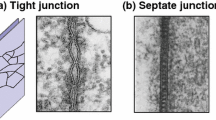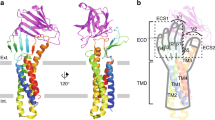Summary
A comparison of the tight-junctions of various cell types in the nasal epithelia of frog, ox, rat and dog shows that Bowman's gland cells have lowest number of strands (4–8), whereas olfactory receptor and supporting, and ciliated respiratory cells show no conspicuous differences and have 6–11 strands. Tight-junctional strand numbers show slight species-dependent variations. In regions where three cells join (observed for receptor and respiratory cells), fracture faces show two parallel strands which fuse at certain points. These strands run perpendicularly to the rest of the tight-junctional belt, which also shows an increased number of strands (13–16) in this region.
Tight-junctions of mammalian olfactory dendritic endings usually show strands composed of particles, whereas those of the other three epithelial cell types consist of continuous or discontinuous bars. Tight-junctions of dendritic endings of the frog also conform to the latter type. Differences in strand density are only slight and range from 16–27 strands/μm. Small angular gap-junctions were observed only within the tight-junctions of supporting cells in the rat.
Similar content being viewed by others
References
Akisaka T, Oda M (1978) Taste buds in the vallate papillae of the rat studied with freeze-fracture preparation. Arch Histol Jpn 41:87–98
Altner H, Altner I (1974) Cell apices and cell contacts in the vertebrate olfactory epithelium as revealed by freeze fracturing and tracer experiments. In: Poynder TM (ed) Transduction mechanisms in chemoreception. Information Retrieval Ltd, London, pp 59–70
Altner H, Altner-Kolnberger I (1974) Freeze-fracture and tracer experiments on the permeability of zonulae occludentes in the olfactory mucosa of vertebrates. Cell Tissue Res 154:51–59
Bagger-Sjöbäck D, Flock Å (1977) Freeze-fracturing of the auditory basilar papilla in the lizard Calotes versicolor. Cell Tissue Res 177:431–443
Bertalanffy FD, Lau C (1962) Cell renewal. Int Rev Cytol 13:357–366
Bullivant S (1978) The structure of tight-junctions. In: Sturgess JM (ed) Ninth International Congress on Electron Microscopy, Vol. III. State of the Art Symposia. Microscopical Society of Canada, Toronto, pp 659–672
Claude P (1978) Morphological factors influencing transepithelial permeability: A model for the resistance of the zonula occludens. J Membrane Biol 39:219–232
Claude P, Goodenough DA (1973) Fracture faces of zonulae occludentes from “tight” and “leaky” epithelia. J Cell Biol 58:390–400
Erlij D, Martínez-Palomo A (1978) role of tight junctions in epithelial function. In: Giebisch G (ed) Transport Across Multi-Membrane Systems. Springer, Berlin Heidelberg New York, pp 27–53
Graziadei PPC, Graziadei GAM (1978) Continuous nerve cell renewal in the olfactory system. In: Jacobson M (ed) Handbook of Sensory Physiology. Vol IX: Development of Sensory Systems. Springer-Verlag, Berlin Heidelberg New York, pp 55–83
Graziadei PPC, Graziadei GAM (1979) Neurogenesis and neuron regeneration in the olfactory system of mammals. I. Morphological aspects of differentiation and structural organization of the olfactory sensory neurons. J Neurocytol 8:1–18
Inoue S, Hogg JC (1977) Freeze-etch study of the tracheal epithelium of normal guinea pigs with particular reference to intercellular junctions. J Ultrastruct Res 61:89–99
Iurato S, Franke K, Luciano L, Wermbter G, Pannese E, Reale E (1976) Fracture faces of the junctional complexes in the reticular membrane of the organ of Corti. Acta Otolaryngol (Stockh) 81:36–47
Jahnke K (1976) The fine structure of freeze-fractured intercellular junctions in the guinea pig inner ear. Acta Otolaryngol (Stockh) Suppl 336:5–40
Jahnke K, Baur P (1979) Freeze-fracture study of taste bud pores in the foliate papillae of the rabbit. Cell Tissue Res 200:245–256
Kerjaschki D (1978) Some freeze-etching data on the olfactory epithelium. In: Le Magnen J, Mac Leod P (eds) Olfaction and Taste VI. Information Retrieval Ltd, London Washington, pp 75–85
Kerjaschki D, Hörandner H (1976) The development of mouse olfactory vesicles and their cell contacts: A freeze-etching study. J Ultrastruct Res 54:420–444
Luciano L, Thiele J, Reale E (1979) Development of follicles and of occluding junctions between the follicular cells of the thyroid gland. A thin-section and freeze-fracture study in the fetal rat. J Ultrastruct Res 66:164–181
Mart/'inez-Palomo A, Erlij D (1975) Structure of tight junctions in epithelia with different permeability. Proc Natl Acad Sci USA 72:4487–4491
McNutt NS (1977) Freeze-fracture techniques and applications to the structural analysis of the mammalian plasma membrane. In: Poste G, Nicolson GL (eds) Dynamic Aspects of Cell Surface Organization. Cell Surface Reviews, Vol. 3. North-Holland Publishing Company, Amsterdam, pp 75–126
Menco BPhM (1977) A qualitative and quantitative investigation of olfactory and nasal respiratory mucosal surfaces of cow and sheep based on various ultrastructural and biochemical methods. Communications Agricultural University Wageningen 77–13:1–157
Menco BPhM (1980a) Qualitative and quantitative freeze-fracture studies on olfactory and nasal respiratory epithelial structures of frog, ox, rat and dog. I. A general survey. Cell Tissue Res 207:183–209
Menco BPhM (1980b) Qualitative and quantitative freeze-fracture studies on olfactory and nasal respiratory epithelial surfaces of frog, ox, rat and dog. II. Cell apices, cilia and microvilli. Cell Tissue Res 211:5–29
Menco BPhM (1980c) Qualitative and quantitative freeze-fracture studies on olfactory and nasal respiratory epithelial surfaces of frog, ox, rat and dog. IV. Ciliogenesis and ciliary necklaces (including high-voltage observations). Cell Tissue Res 211:5–29
Mendoza AS, Miragall F, Breipohl W (1979) Intercellular junctions during the development of the olfactory epithelium in the chick. J Submicrosc Cytol 12:29–41
Miragall F, Breipohl W, Bhatnagar K (1979) Ultrastructural investigation on the cell membranes of the vomeronasal organ in the rat: A freeze-etching study. Cell Tissue Res 200:397–408
Møllgård K, Malinowska DH, Saunders NR (1976/77) Lack of correlation between tight junction morphology and permeability properties in developing choroid plexus. Nature 264:293–294; Nature 267:182–183
Müller W (1980) Cell junctions with funnels in the olfactory mucosa of frogs (Rana temporaria L.) Cell Tissue Res 207:165–169
Roesinger B, Schiller A, Taugner R (1978) A freeze-fracture study of tight junctions in the pars convoluta and pars recta of the renal proximal tubule. Cell Tissue Res 186:121–133
Satir P, Satir B (1974) Design and function of site-specific particle arrays in the cell membrane. In: Control of Proliferation of Animal Cells. Cold Spring Harbor Laboratory, Cold Spring Harbor, New York, pp 233–249
Stackpole CW (1978) Topographical differentiation of the cell surface. Progr Surf Membr Sci 12:1–182
Staehelin LA (1974) Structure and function of intercellular junctions. Int Rev Cytol 39:191–283
Suzuki F, Nagano T (1979) Morphogenesis of tight junctions in the peritoneal mesothelium of the mouse embryo. Cell Tissue Res 198:247–260
Usukura J, Yamada E (1978) Observations on the cytolemma of the olfactory receptor cell in the newt. 1. Freeze replica analysis. Cell Tissue Res 188:83–98
Van Deurs B, Koehler JK (1979) Tight junctions in the choroid plexus epithelium. A freeze-fracture study including complementary replicas. J Cell Biol 80:662–673
Van Deurs B, Luft JH (1979) Effects of glutaraldehyde fixation on the structure of tight junctions. A quantitative freeze-fracture analysis. J Ultrastruct Res 68:160–172
Wade JB, Karnovsky JM (1974) The structure of the zonula occludens. A single fibril model based on freeze-fracture. J Cell Biol 60:168–180
Author information
Authors and Affiliations
Rights and permissions
About this article
Cite this article
Menco, B.P.M. Qualitative and quantitative freeze-fracture studies on olfactory and nasal respiratory epithelial surfaces of frog, ox, rat, and dog. Cell Tissue Res. 211, 361–373 (1980). https://doi.org/10.1007/BF00234393
Accepted:
Issue Date:
DOI: https://doi.org/10.1007/BF00234393




